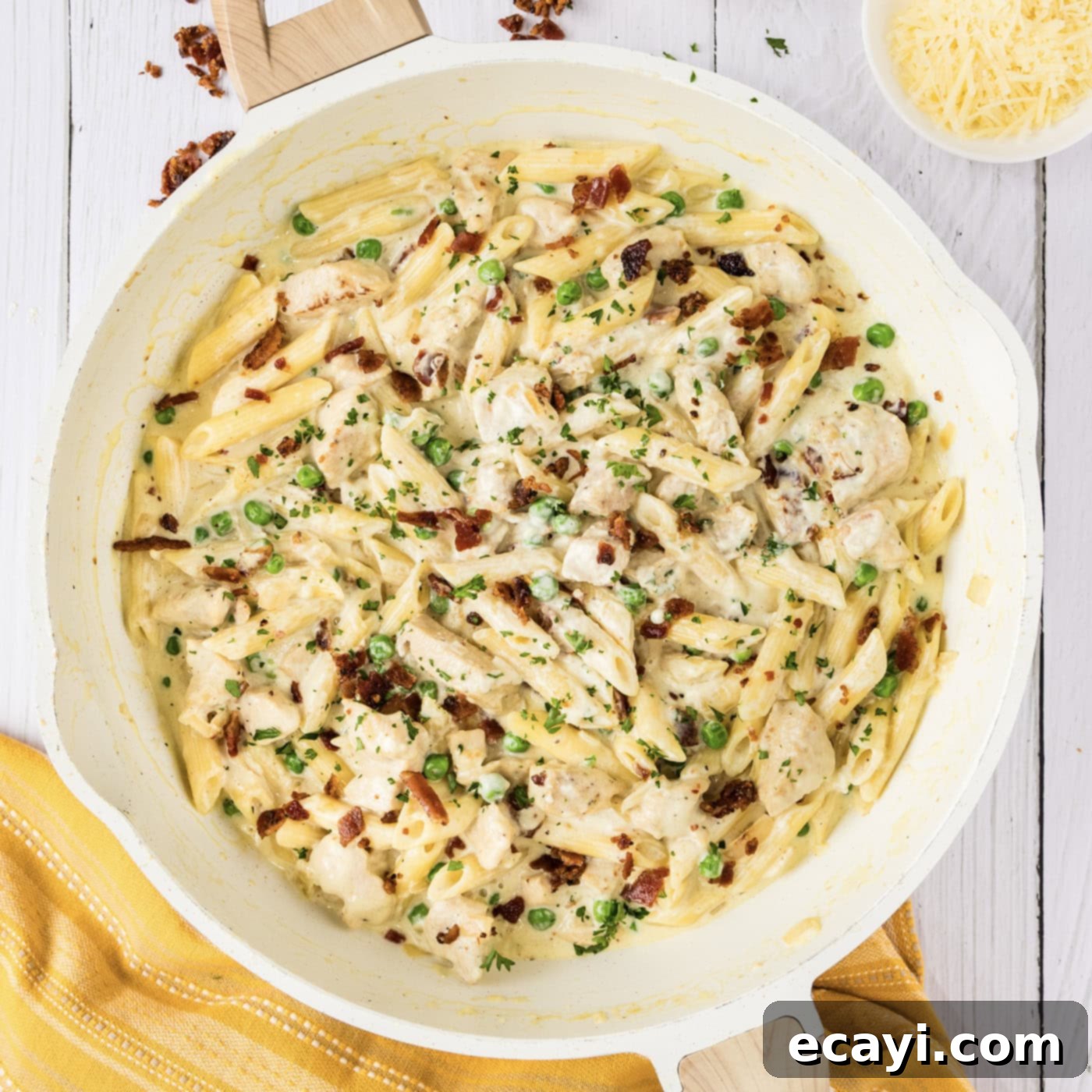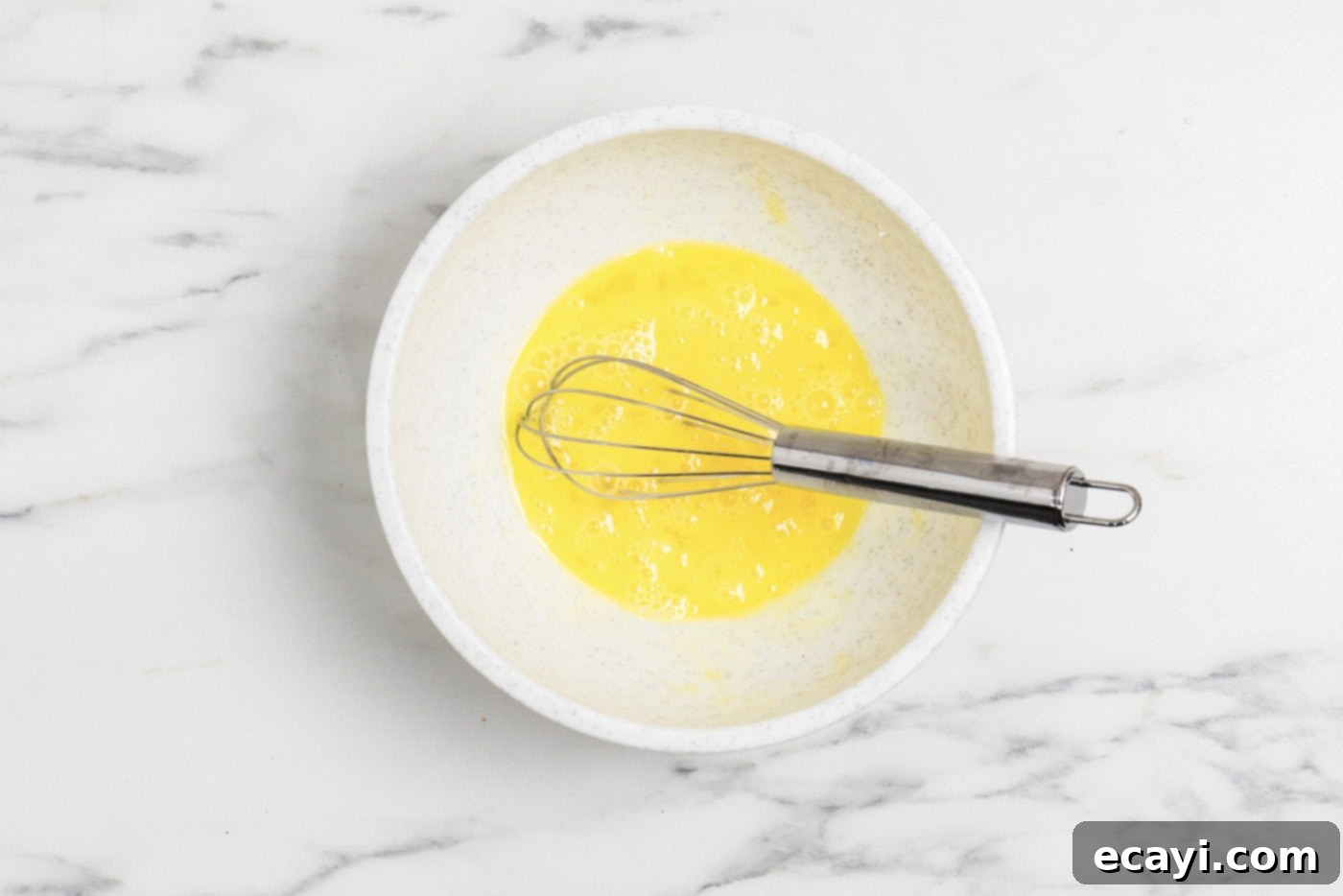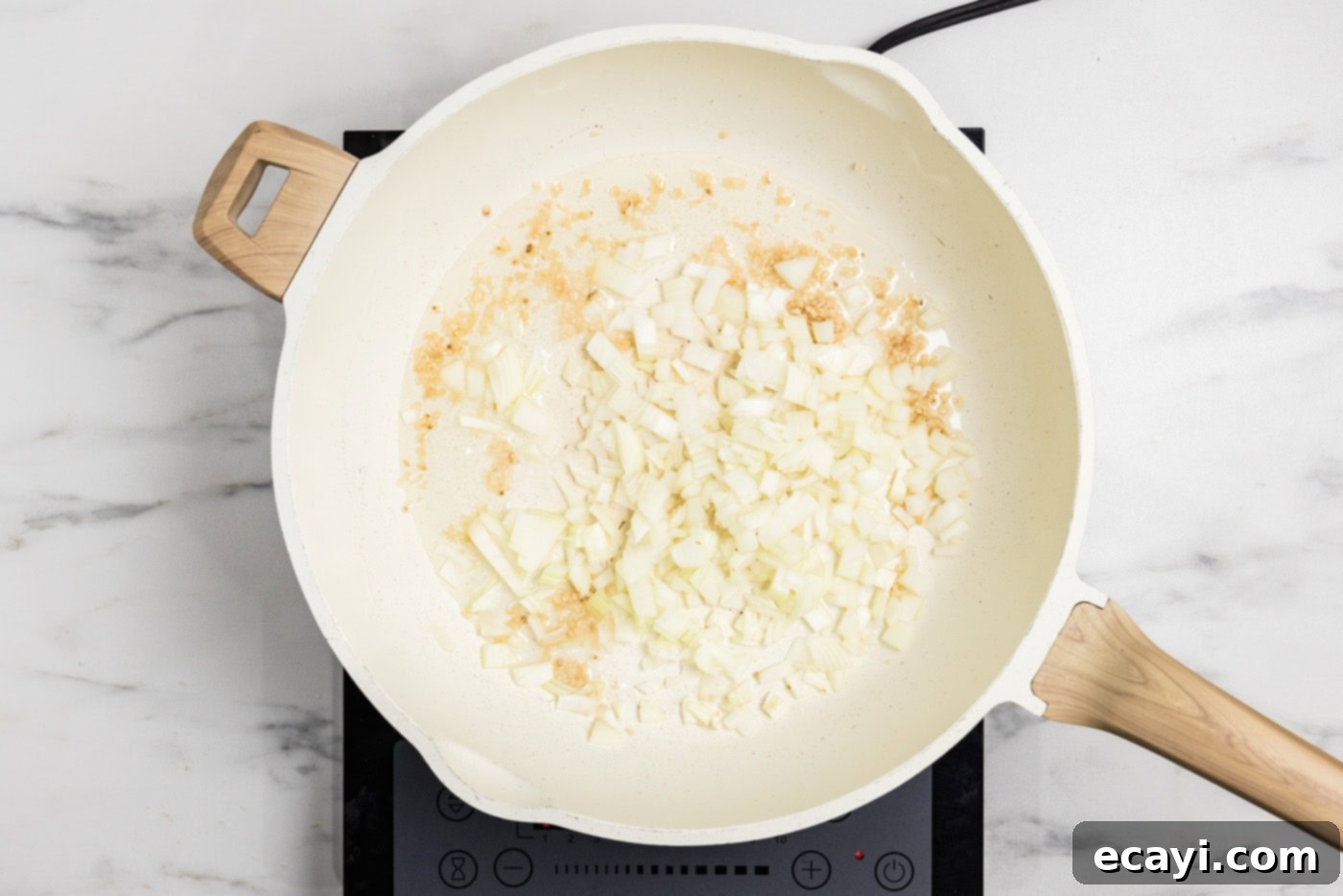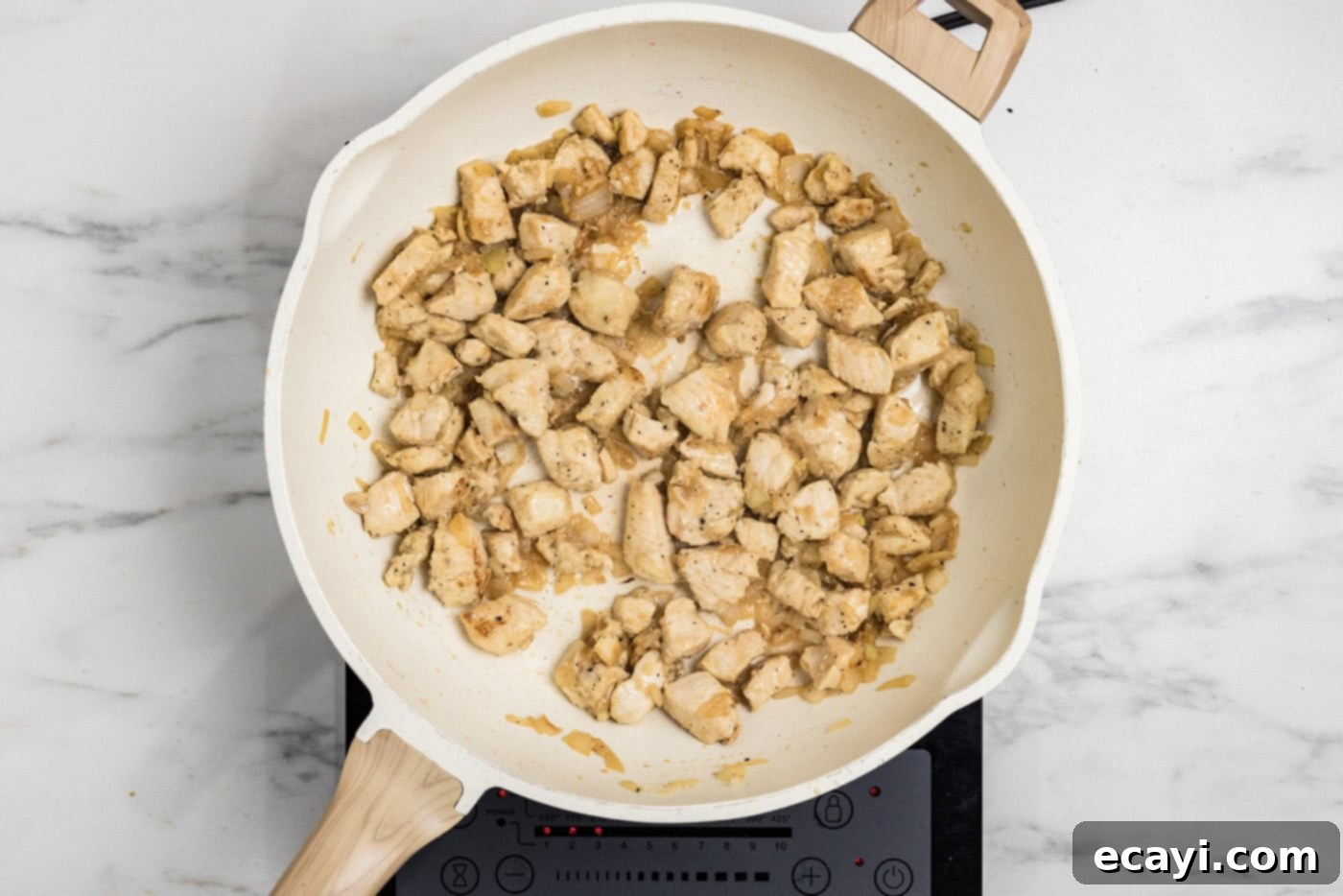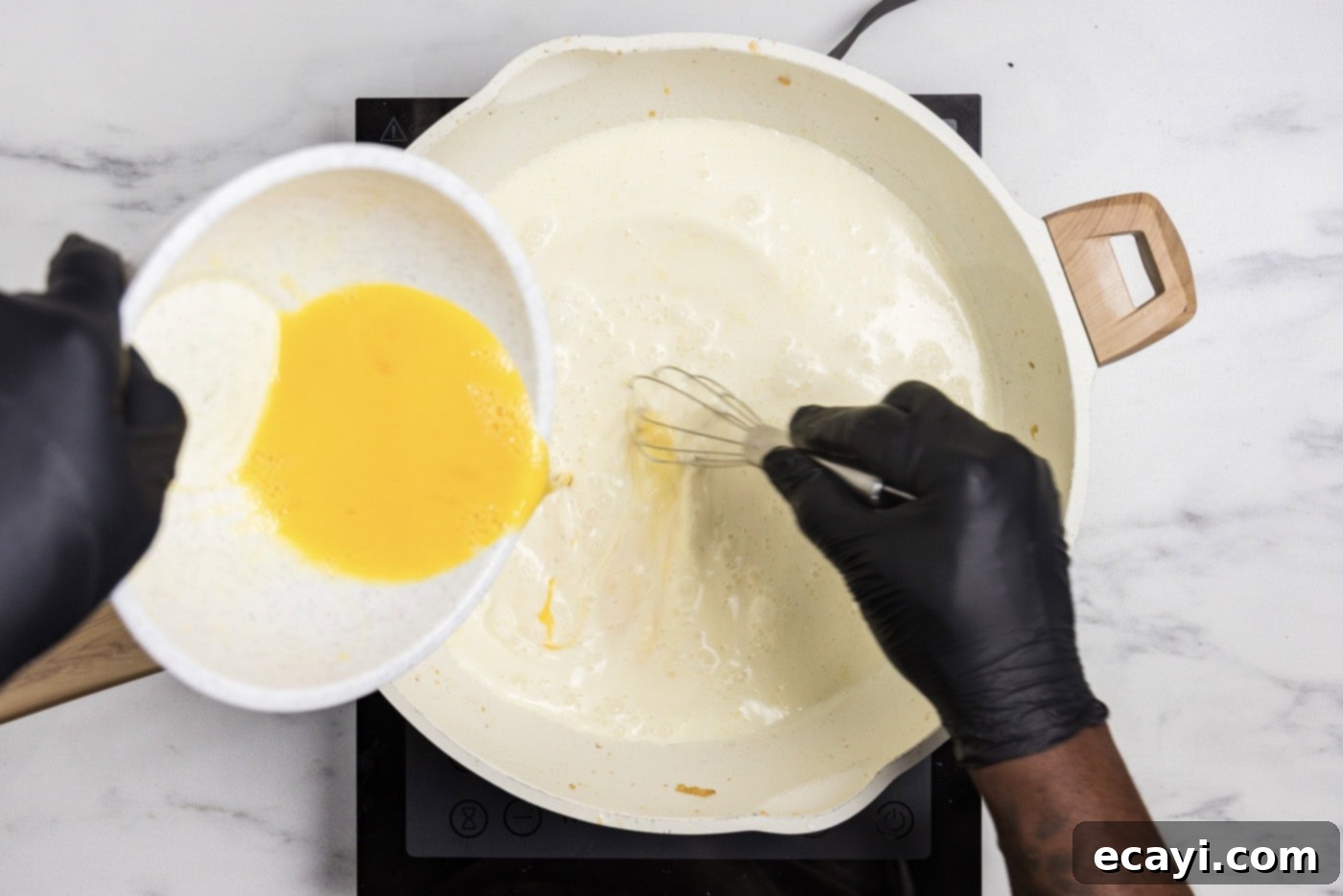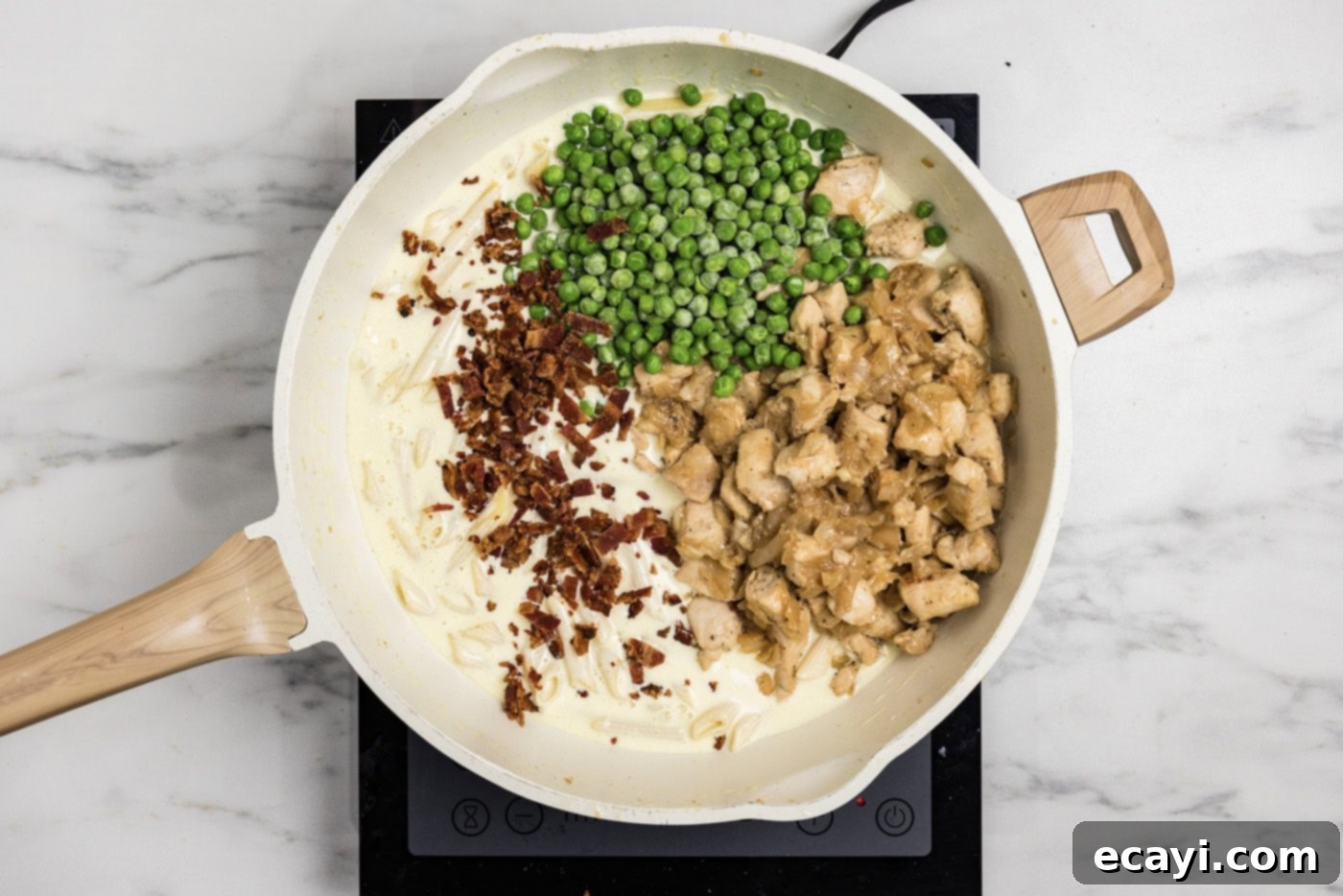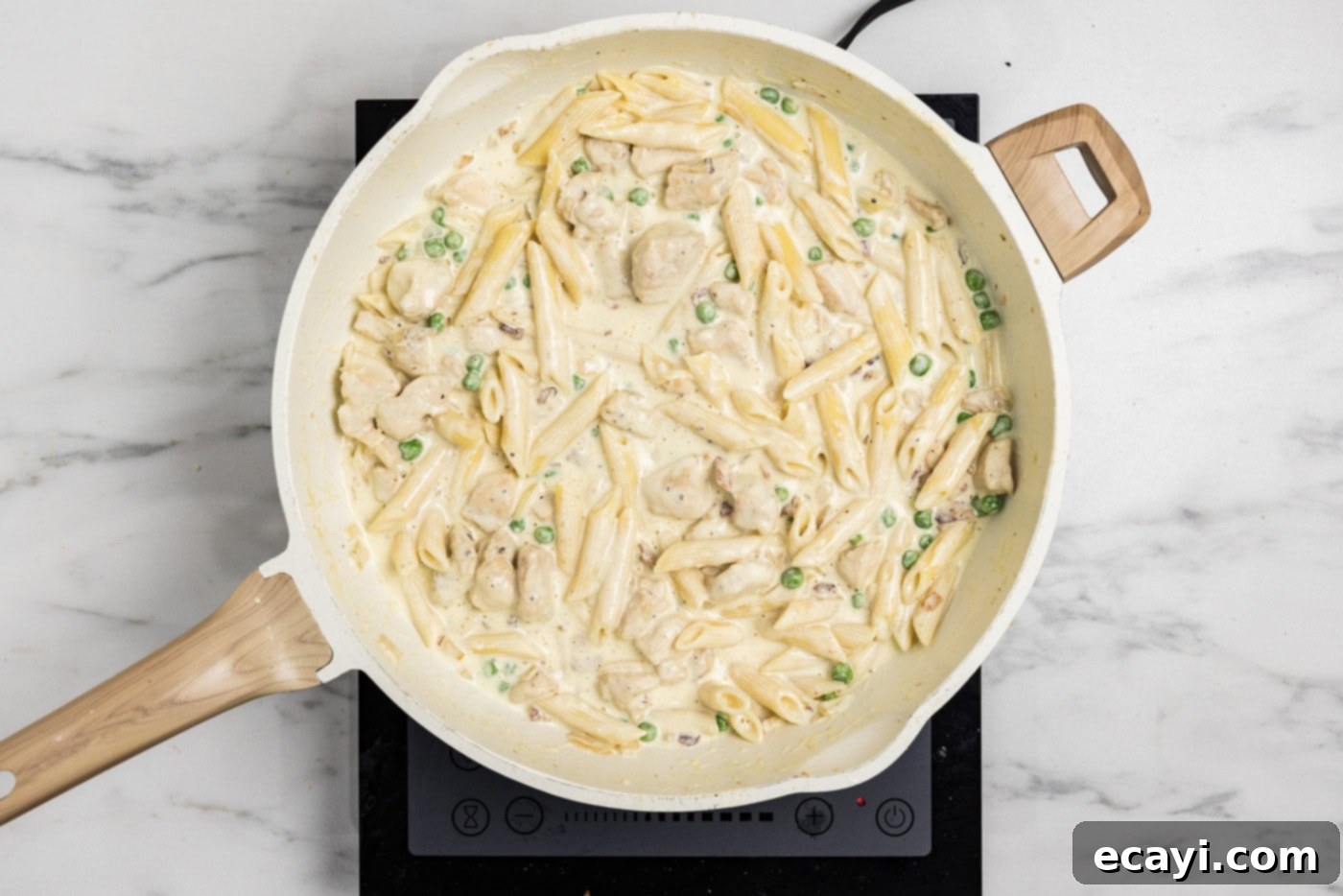Easy & Creamy Chicken Carbonara Recipe: A Rich American Favorite
Indulge in this delightful Americanized Chicken Carbonara recipe, a comfort food classic featuring tender chicken, crispy bacon, and sweet green peas, all generously coated in an irresistibly creamy garlic and Parmesan cheese sauce. This dish offers a luxurious, restaurant-quality experience right in your home, perfect for a satisfying weeknight meal or a special occasion.
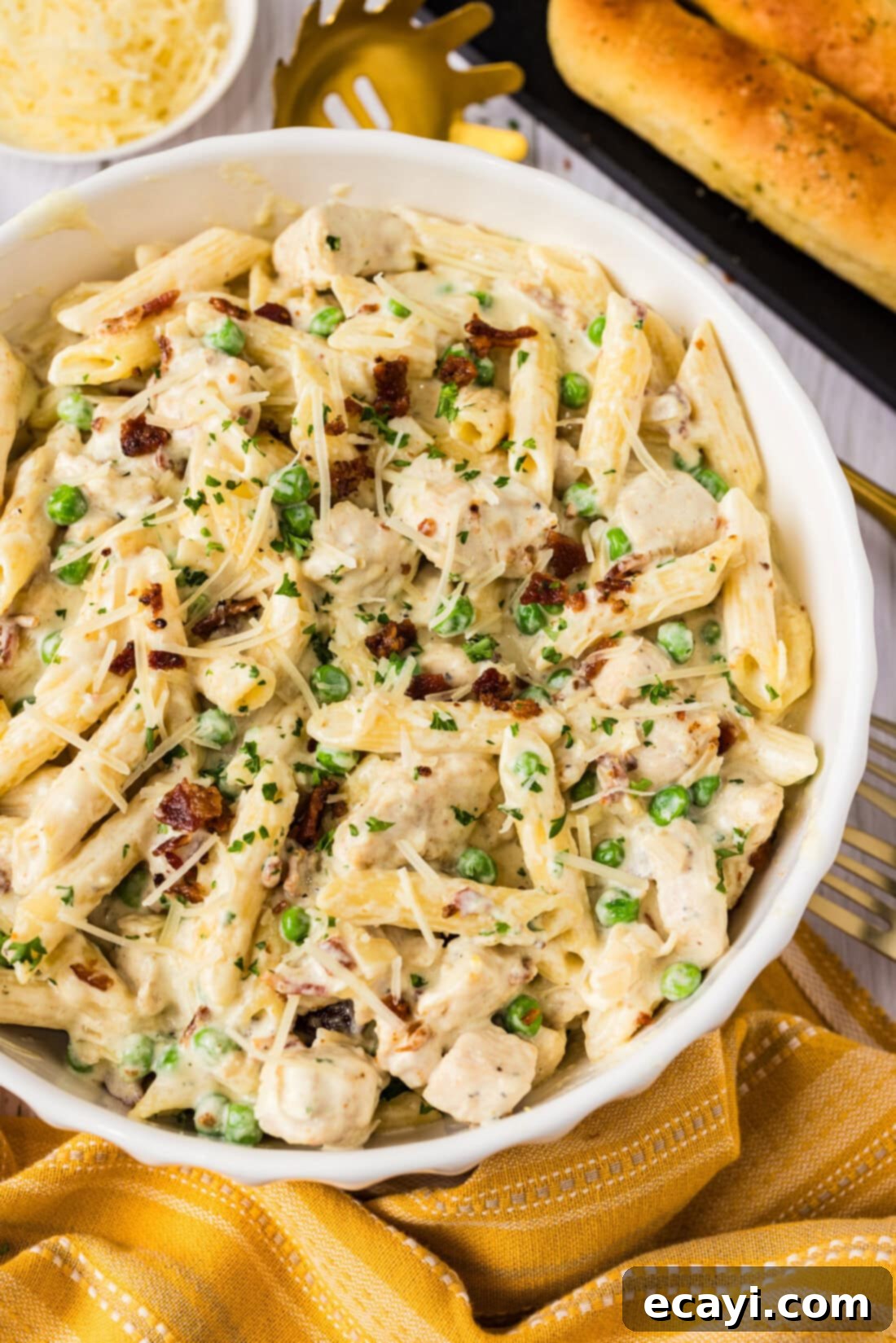
Why This Creamy Chicken Carbonara Recipe Is a Must-Try
While the authentic Italian pasta carbonara relies solely on eggs, Pecorino Romano, guanciale, and black pepper, our American version embraces a richer, creamier profile that has won over countless palates. This recipe delivers all the comforting flavors you crave, enhanced with succulent chicken and bright green peas, making it a hearty and complete meal.
The true magic behind the luxuriously thick and silky sauce in this chicken carbonara lies in the art of tempering eggs. This technique, though seemingly complex, is surprisingly simple and utterly crucial. By slowly incorporating whisked eggs into a hot cream base, we achieve a sauce that boasts a smooth, almost custard-like texture without the eggs scrambling. This creates a deeply satisfying mouthfeel, a hallmark of a truly great carbonara, blending seamlessly with the smoky notes of bacon, the savory chicken, and the sharp tang of Parmesan cheese. It’s this harmonious combination that makes this dish an enduring favorite, inviting you back for more with every forkful.
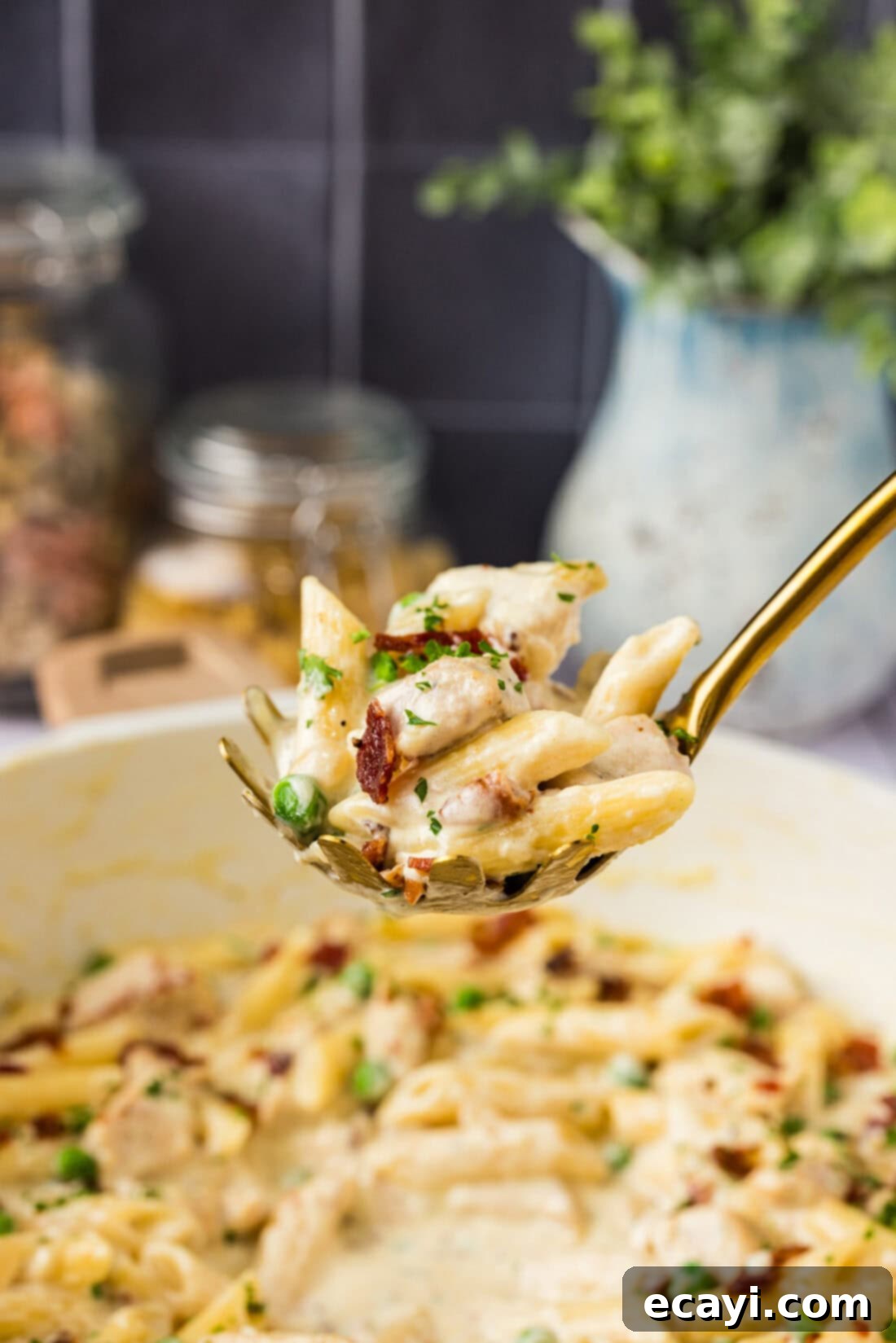
Essential Ingredients for Your Chicken Carbonara
To create this magnificent dish, you’ll need a selection of fresh and pantry staples. Find the precise measurements and detailed instructions in the printable recipe card located at the end of this article. Gathering your ingredients before you start cooking will ensure a smooth and enjoyable culinary process.
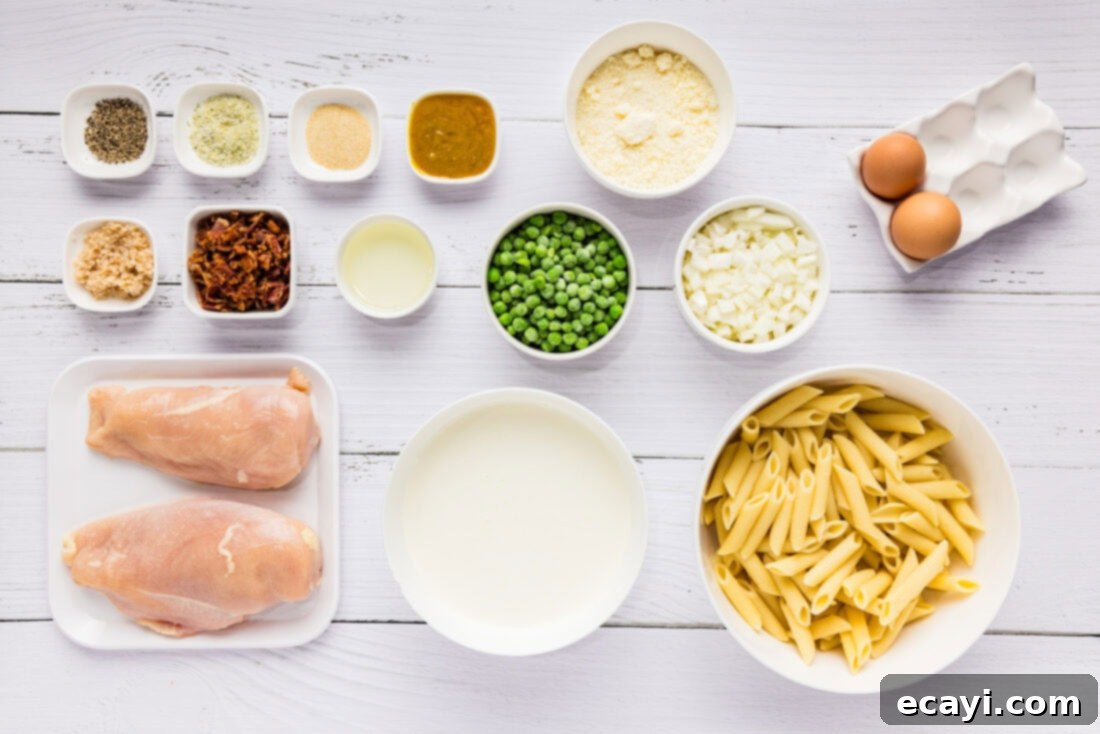
Ingredient Spotlight & Smart Substitutions
Understanding your ingredients and their roles can elevate your cooking. Here are some insights and suggestions for this chicken carbonara recipe:
- Pasta: We opted for penne pasta in this recipe, known for its ability to hold creamy sauces within its ridged tubes. However, carbonara is incredibly versatile when it comes to pasta shapes. Classic choices include long strands like fettuccine, linguine, or spaghetti, which beautifully intertwine with the sauce. For those who prefer shorter shapes, rotini, farfalle (bow-tie pasta), rigatoni, elbows, and mostaccioli are all excellent replacements. These shapes provide different textures and ensure every bite is coated in that rich sauce. We generally advise against using angel hair pasta due to its delicate nature; it tends to break apart or become mushy when stirred into such a hearty sauce.
- Sauce Base: The foundation of our luscious sauce is heavy cream. Its high-fat content is key to achieving that rich, decadent texture. If heavy cream isn’t available or you’re looking for a slightly lighter option, half and half can be used as a substitute, though the sauce might be marginally less thick. Whole milk can also work in a pinch, but be aware that any liquid with a lower milk fat content may require a bit more cooking time to reach the desired creamy consistency. Be patient and stir gently to prevent scorching.
- Bacon: Smoky bacon adds a crucial layer of flavor and texture to carbonara. Its crispy, salty goodness is a perfect counterpoint to the creamy sauce. For an equally delicious alternative, consider using pancetta, an Italian cured pork belly. Pancetta offers a similar savory depth but with a slightly different flavor profile. You can also experiment with diced prosciutto for a milder, more delicate touch.
- Chicken: Boneless, skinless chicken breasts are our protein of choice, cut into bite-sized cubes for even cooking and easy incorporation into the pasta. You could also use boneless, skinless chicken thighs for a slightly richer flavor and juicier texture. Ensure the chicken is trimmed of any excess fat before cubing.
- Aromatics: Freshly minced garlic and chopped onion provide the aromatic base that deepens the flavor of the entire dish. Don’t skimp on these; they are essential for building a robust flavor profile.
- Cheese: Parmesan cheese is non-negotiable for its sharp, salty, and nutty notes. Grated fresh Parmesan will always yield the best flavor and meltability. Avoid pre-grated cheeses that contain anti-caking agents, as these can affect the sauce’s texture.
- Peas: Frozen green peas add a pop of color, a touch of sweetness, and a lovely textural contrast to the rich carbonara. They are quick to cook and a convenient addition. Fresh peas can also be blanched and used if available.
- Seasonings: A simple blend of garlic salt, onion powder, and black pepper enhances the natural flavors of the chicken without overpowering the sauce. Adjust to your taste preferences.
- Chicken Base: We prefer using a concentrated chicken base, like “Better Than Bouillon,” for its intense flavor and convenience. It takes up less pantry space and is easily reconstituted. If you don’t have chicken base, you can substitute with an equal amount of good quality chicken broth or stock, keeping in mind you might need slightly less cream to achieve the desired thickness if using liquid broth.
Step-by-Step Guide to Crafting Chicken Carbonara
These step-by-step photos and detailed instructions are designed to help you visualize each stage of this recipe. For a convenient printable version, complete with precise measurements and instructions, scroll down to the Jump to Recipe section at the bottom of this post.
- Cook the Pasta: Begin by cooking your chosen pasta shape, such as penne, according to the package directions until it reaches an al dente consistency. This ensures the pasta retains a slight bite and won’t become overly soft when combined with the sauce. Once cooked, drain the pasta and immediately rinse it under cold water. This crucial step halts the cooking process, preventing it from becoming mushy.
TIP: To prevent the cooked pasta from sticking together while you prepare the other components, toss it with a small amount of olive oil. Alternatively, you can submerge it in cool water until you’re ready to add it to the skillet.
- Prepare the Chicken: While the pasta cooks, take your boneless, skinless chicken breasts. Carefully trim off any excess fat, then cut the chicken into uniform, bite-sized cubes. Place the cubed chicken into a large mixing bowl.
- Season the Chicken: Season the chicken cubes generously with garlic salt, onion powder, and freshly ground black pepper. Use gloved hands to toss the chicken thoroughly, ensuring each piece is evenly coated with the spices. This enhances the flavor of the chicken before searing.
- Whisk the Eggs: In a medium-sized bowl, whisk the two large eggs until the yolks and whites are fully combined and slightly frothy. Set this aside, as it will be used to create the rich, silky sauce.

- Sauté Aromatics: Heat two tablespoons of olive oil in a large skillet over medium-high heat. Wait until the oil is shimmering, indicating it’s hot enough. Add the minced garlic and chopped onion to the hot skillet. Sauté for 1-2 minutes, stirring constantly, until the onions are softened and translucent, and the garlic is fragrant but not browned.

- Cook the Chicken: Add the seasoned chicken cubes to the skillet with the sautéed aromatics. Cook for approximately 10-15 minutes, turning the chicken occasionally to ensure even cooking. Continue until no pink remains in the chicken and some desirable browning has occurred on the exterior. Once cooked, remove the chicken from the skillet and transfer it to a plate, covering it loosely to keep warm.

- Prepare the Cream Base: Into the same skillet (no need to clean it, the leftover flavors are a bonus!), pour the heavy whipping cream and add the chicken base. Whisk these ingredients together thoroughly until well combined. Heat this mixture gently, just until it’s hot and small, tiny bubbles begin to form around the edges. It’s crucial not to let the cream boil or scorch, as this can affect the final sauce texture.
- Temper the Eggs: This is the key step for a silky carbonara sauce. Slowly drizzle the whisked eggs into the hot cream mixture while continuously whisking. This gradual addition and constant motion prevent the eggs from scrambling, allowing them to slowly warm and integrate into the sauce, creating a smooth, luscious consistency. The sauce should remain liquid and creamy, not lumpy.

- Add Parmesan: Sprinkle the grated Parmesan cheese into the tempered cream and egg mixture. Continue to whisk until the cheese is completely melted and thoroughly combined, contributing its savory depth to the sauce.
- Combine All Ingredients: Finally, add the cooked penne pasta, the previously cooked chicken, the frozen peas, and the chopped cooked bacon into the skillet with the sauce. Stir all the ingredients well, ensuring every piece of pasta, chicken, and pea is coated in the creamy carbonara sauce. Heat through gently for a few minutes until everything is warmed and perfectly integrated.


Frequently Asked Questions & Expert Tips for Perfect Carbonara
Tempering eggs is the cornerstone of a smooth carbonara sauce. The key is a gradual process: drizzle the whisked eggs into the hot cream base very slowly and whisk continuously throughout the addition. The hot liquid gradually raises the temperature of the eggs without cooking them rapidly, allowing them to thicken the sauce rather than solidify. If you pour the eggs in too quickly or stop whisking, you risk cooking them into stringy bits, similar to egg drop soup, instead of creating a velvety sauce.
If your carbonara sauce cooks for too long or is exposed to excessively high heat, it may become overly thick. To easily remedy this, simply add a splash of reserved pasta water, cream, or even milk, a little at a time, while gently stirring. Continue adding until you achieve your desired silky and pourable consistency.
Store any leftover chicken carbonara in an airtight container in the refrigerator for up to 4 days. When reheating, it’s best to do so gently over the stovetop on low heat. Add a small amount of water, cream, or milk as you reheat, stirring constantly, to help loosen the sauce and restore its creamy texture, as it tends to thicken in the refrigerator.
Expert Tips for the Best Chicken Carbonara:
- Quality Ingredients Matter: Using fresh, high-quality Parmesan cheese (grated from a block) and fresh garlic will significantly impact the flavor of your sauce.
- Mise en Place: Prepare all your ingredients (chop chicken, dice onion, whisk eggs, cook pasta) before you start cooking the sauce. Carbonara comes together quickly, so having everything ready will prevent stress and ensure success.
- Don’t Overcook the Sauce: Keep an eye on the cream and egg mixture. You want it hot enough to temper the eggs but not boiling, which can lead to scorching or scrambling.
- Serve Immediately: Carbonara is best enjoyed fresh off the stove. The sauce is at its creamiest and most decadent when hot.
- Flavor Boost: For an extra layer of flavor, consider cooking the bacon first, then using a tablespoon or two of the rendered bacon fat to sauté the chicken instead of olive oil.
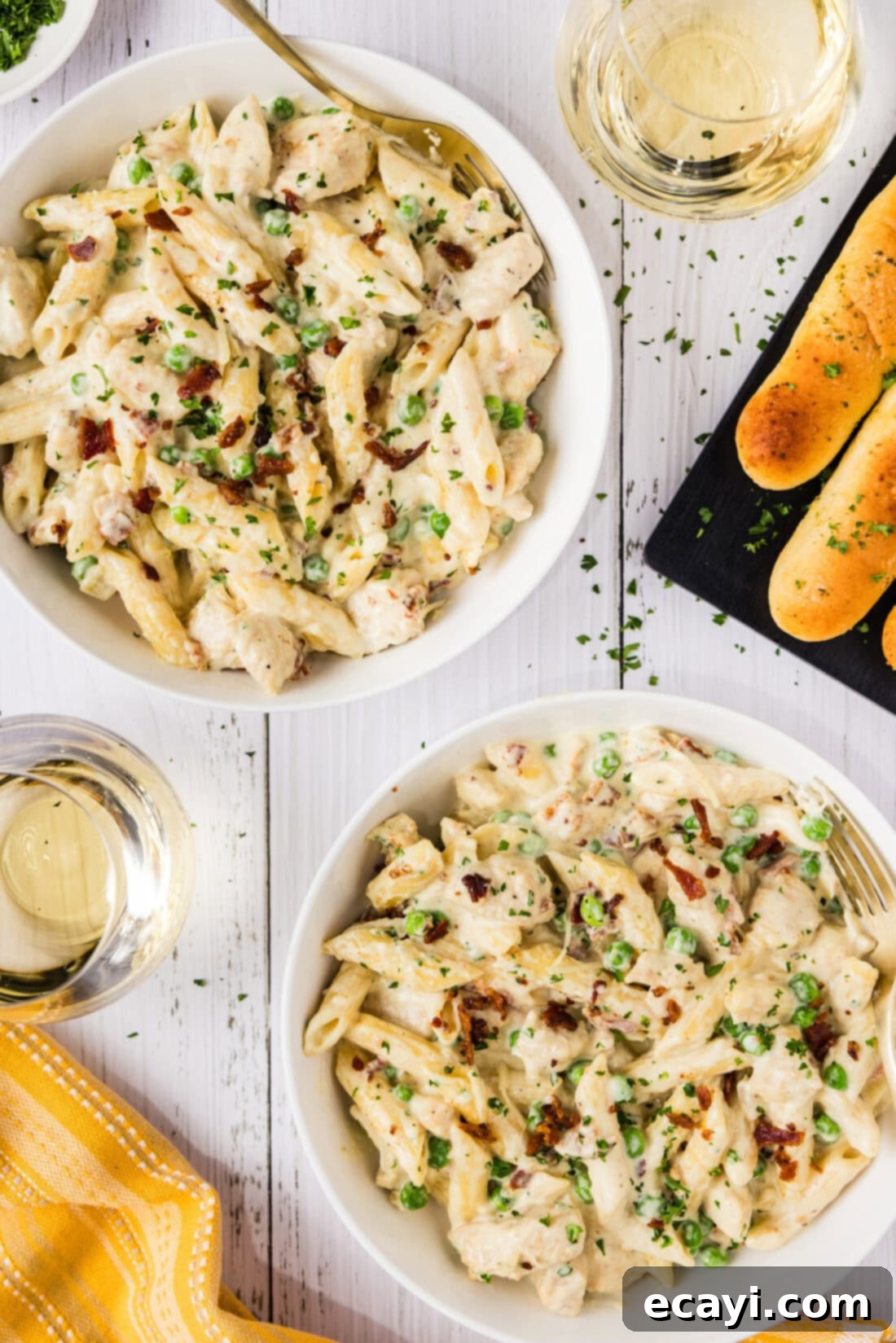
Perfect Serving Suggestions for Your Carbonara
This rich chicken carbonara is a complete meal on its own, but pairing it with a simple side can truly elevate the experience. We highly recommend serving it alongside slices of crusty garlic bread, perfect for soaking up every last drop of that creamy sauce. A refreshing, leafy dinner salad, such as a crisp Caesar salad, provides a lovely contrast to the richness of the pasta. For an extra touch, garnish each serving with a sprinkle of freshly chopped parsley and a few more crumbles of crispy bacon.
Explore More Delicious Pasta Recipes
- Creamy Chicken Alfredo
- Hearty Chicken Tetrazzini
- Simple Garlic Butter Pasta
- Elegant Chicken and Shrimp Carbonara
I genuinely love to bake and cook, and it brings me joy to share my kitchen adventures and recipes with all of you! Remembering to come back each day for new ideas can be tough, which is why I offer a convenient newsletter delivered directly to your inbox every time a new recipe posts. Simply subscribe today and start receiving your free daily recipes!
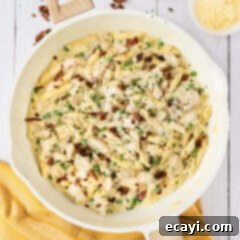
Chicken Carbonara
This easy chicken carbonara recipe is silky and rich with a garlic parmesan cream sauce!
IMPORTANT – There are often Frequently Asked Questions within the blog post that you may find helpful. Simply scroll back up to read them!
Print It
Pin It
Rate It
Save It
Course: Dinner
Cuisine: American
Servings: 4 servings (8 cups total)
Total Time: 50 mins
Calories: 1081
Author: Amanda Davis
Ingredients
- 8 ounces penne pasta (about 5 cups cooked)
- 1.5 pounds boneless skinless chicken breasts (680g), 2 large breasts
- ½ teaspoon garlic salt
- ½ teaspoon onion powder
- ¼ teaspoon black pepper
- 2 large eggs
- 2 Tablespoons olive oil
- 1 Tablespoon minced garlic
- 1 cup chopped onion
- 2 cups heavy whipping cream
- 2 Tablespoons Better than Bouillon chicken base
- ½ cup grated Parmesan cheese
- 1 cup frozen peas
- ½ cup chopped cooked bacon
Things You’ll Need
- Chef’s knife
- Cutting board
- Whisk
- Large heavy bottomed skillet
Before You Begin
- The heavy cream is what makes this dish rich and creamy. Half and half can be used in place of heavy cream if needed. Whole milk will also work, but anything with less milk fat than that may require more cooking time to thicken up.
- We used penne pasta here, though chicken carbonara is commonly made with either fettuccine, linguine, or spaghetti noodles. Most pasta shapes can be used for this recipe. We have used rotini and spaghetti noodles, but farfalle, rigatoni, elbows, and mostaccioli are all good replacements. We don’t recommend angel hair pasta simply because of its delicate nature.
- We use a concentrated bouillon base for most of our recipes instead of broth or stock. It’s convenient, takes up a lot less space, and is easily reconstituted with water. You can certainly use broth or stock instead.
Instructions
-
Cook pasta al dente, according to package instructions. Drain and rinse under cold water to stop the cooking process.
Toss cooked pasta with a little olive oil to keep it from sticking together, or you can submerge it in cool water until you are ready to add it to the skillet.
Ingredients: 8 ounces penne pasta
-
Meanwhile, trim any fat off the chicken and cut it into cubes. Place in a large bowl.
Ingredients: 1.5 pounds boneless skinless chicken breasts
-
Season chicken with garlic salt, onion powder, and pepper. Toss together with gloved hands.
Ingredients: 1/2 teaspoon garlic salt, 1/2 teaspoon onion powder, 1/4 teaspoon black pepper
-
In a medium bowl, whisk the eggs. Set aside.
Ingredients: 2 large eggs
-
Heat olive oil in a skillet over medium-high heat until shimmering.
Ingredients: 2 Tablespoons olive oil
-
Add garlic and onion, saute 1-2 minutes.
Ingredients: 1 Tablespoon minced garlic, 1 cup chopped onion
-
Add chicken cubes to the skillet and cook about 10-15 minutes, turning occasionally, until no pink remains and some browning has occurred. Remove chicken to a plate and keep warm.
-
To the skillet, add the heavy whipping cream and chicken base and whisk together. Heat mixture JUST until hot, tiny bubbles will have formed. You don’t want to scorch the cream.
Ingredients: 2 cups heavy whipping cream, 2 Tablespoons Better than Bouillon chicken base
-
Temper the eggs by slowly drizzling them into the hot cream, whisking continuously.
-
Sprinkle in the parmesan cheese and whisk until melted and well combined.
Ingredients: 1/2 cup grated Parmesan cheese
-
Add cooked penne pasta, cooked chicken, frozen peas, and chopped bacon to the skillet. Stir well and heat through.
Ingredients: 1 cup frozen peas, 1/2 cup chopped cooked bacon
Expert Tips & FAQs
- Store any leftovers in an airtight container kept in the refrigerator for up to 4 days. Reheat gently over the stovetop, adding a small amount of water, cream, or milk to help loosen the sauce if needed.
Nutrition
Serving: 1 serving (2 cups) | Calories: 1081cal | Carbohydrates: 58g | Protein: 62g | Fat: 67g | Saturated Fat: 34g | Polyunsaturated Fat: 5g | Monounsaturated Fat: 21g | Trans Fat: 0.1g | Cholesterol: 362mg | Sodium: 1616mg | Potassium: 1164mg | Fiber: 5g | Sugar: 9g | Vitamin A: 2328IU | Vitamin C: 21mg | Calcium: 253mg | Iron: 3mg
Follow on Pinterest @AmandasCookin or tag #AmandasCookin!
The recipes on this blog are tested with a conventional gas oven and gas stovetop. It’s important to note that some ovens, especially as they age, can cook and bake inconsistently. Using an inexpensive oven thermometer can assure you that your oven is truly heating to the proper temperature. If you use a toaster oven or countertop oven, please keep in mind that they may not distribute heat the same as a conventional full sized oven and you may need to adjust your cooking/baking times. In the case of recipes made with a pressure cooker, air fryer, slow cooker, or other appliance, a link to the appliances we use is listed within each respective recipe. For baking recipes where measurements are given by weight, please note that results may not be the same if cups are used instead, and we can’t guarantee success with that method.
